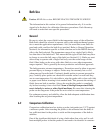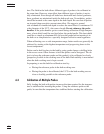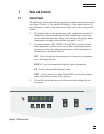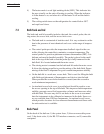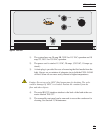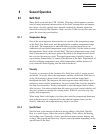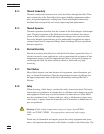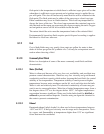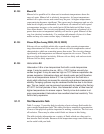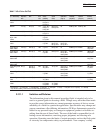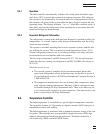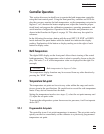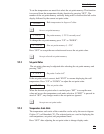
8.1.10.3 Mineral Oil
Mineral oil or paraffin oil is often used at moderate temperatures above the
range of water. Mineral oil is relatively inexpensive. At lower temperatures
mineral oil is quite viscous and control may be poor. At higher temperatures
vapor emission becomes significant. The vapors may be dangerous and use of a
fume hood is highly recommended. As with most oils mineral oil will expand
as temperature increases so be careful not to fill the bath too full that it over
-
flows when heated. The viscosity and thermal characteristics of mineral oil is
poorer than water so temperature stability will not be as good. Mineral oil has
very low electrical conductivity. Use caution with mineral oil since it is flam
-
mable and may also cause serious injury if inhaled or ingested.
8.1.10.4 Silicone Oil (Dow Corning 200.05, 200.10, 200.20)
Silicone oils are available which offer a much wider operating temperature
range than mineral oil. Like most oils, silicone oils have temperature control
characteristics which are somewhat poorer than water. The viscosity changes
significantly with temperature and thermal expansion also occurs. These oils
have very high electrical resistivity. Silicone oils are fairly safe and non-toxic.
Silicone oils are fairly expensive.
8.1.10.5 Halocarbon 0.8
Halocarbon 0.8 is a low temperature fluid with a wide temperature
range. It may be used as low as –90 to –100°C before viscosity be-
comes too great. It may be used as high as 70°C before evaporation be-
comes excessive. Halocarbon does not absorb water and will therefore
form ice at temperatures below 0°C. Ice crystals turn the fluid into a
slush which effectively increases the viscosity and reduces temperature
stability. Pumping systems may be rendered ineffective due to ice block
-
age. The ice (water) can be removed occasionally by heating the fluid up
to 100°C for brief periods of time. Use halocarbon under a fume hood at
higher temperatures to remove vapors. Toxicity is low but caution is al
-
ways recommended. Halocarbon has excellent electrical resistivity. This
fluid is fairly expensive.
8.1.11 Fluid Characteristics Table
Table 2 on page 31 provides help in selecting a heat exchange fluid media for
your constant temperature bath. This table provides a numerical representation
of most of the physical qualities important in making a selection. The list is not
all inclusive. There may be other useful fluids not shown in this listing.
The table includes information on a variety of fluids which are often used as
heat transfer fluid in baths. Because of the temperature range some fluids may
not be useful with your bath.
30
8 General Operation



